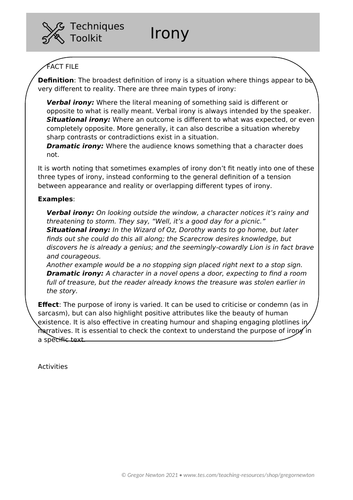



This resource focuses on the language technique irony. The worksheet begins with an information box which explains the three main types of irony, gives an example of each and explains irony’s effect. This is followed by a range of activities which explore the use of each type of irony. Activities include identifying different types of irony in examples, finding verbal irony in everyday situations and completing a description to create situational irony.
The PowerPoint is designed to accompany the worksheet and includes sample answers for one of the worksheet tasks, extension definitions and examples of satire and sarcasm as they relate to irony, and images which depict examples of situational irony.
This resource is suitable for a high school audience. The worksheet is included in both Word and pdf formats to ensure no loss of detail.
Image credit: Tool icon made by Good Ware from Flaticon and used under licence.
This ‘techniques toolkit’ resource is part of a set on language features and techniques in English. Check out these other techniques toolkit resources:
Allusion | Assonance, Consonance, Sibilance | Emotive Language | Euphemism | Focalisation (Point of View) | Iambic Pentameter | Imagery | Irony | Juxtaposition | Metaphor | Modality | Personification | Symbolism | Tone and Mood
Something went wrong, please try again later.
This resource hasn't been reviewed yet
To ensure quality for our reviews, only customers who have purchased this resource can review it
Report this resourceto let us know if it violates our terms and conditions.
Our customer service team will review your report and will be in touch.